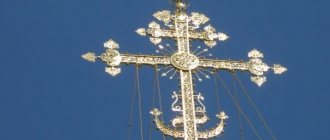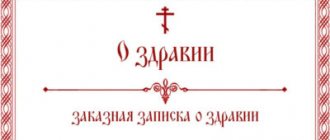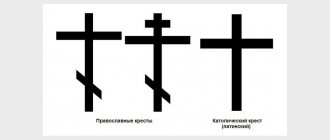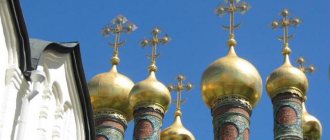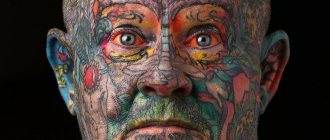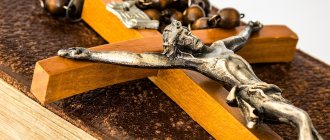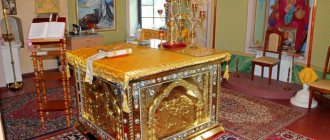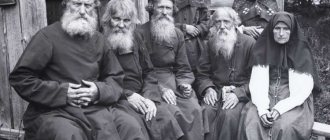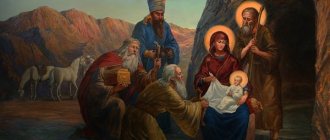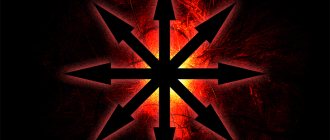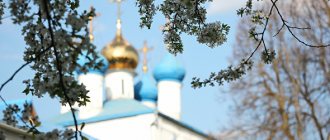Even those Orthodox Christians who have been churched for quite a long time often do not know the correct answer to the question of what the oblique crossbar on the cross means. First we need to figure out what an Orthodox cross actually is. The cross that we are used to seeing on church domes goes by a number of other names: Russian-Byzantine, Orthodox Byzantine, aka the cross of St. Lazarus. Today it is this eight-pointed cross is a symbol of the modern Orthodox Church, although several more options are officially allowed.
What does the inclined crossbar on an Orthodox cross mean?
“...not by the number of trees, not by the number of ends, the Cross of Christ is revered by us, but by Christ Himself, whose most holy blood was stained...” St. Dmitry Rostovsky
History of the eight-pointed cross
The main distinguishing feature of an eight-pointed cross from a four-pointed one is the additional crossbars . Above the head of the crucified Jesus was a sign on which was written mockingly, “Jesus of Nazareth, King of the Jews” - in Aramaic, Greek and Latin. And under the feet of Christ, in the lower half, there was an oblique crossbar-foot . It is believed that this is the most authentic form of the cross on which the Savior was crucified and it is the one that is most widespread in the Russian Orthodox tradition.
Some forms of Orthodox crosses.
Some facts from history:
- Who and when invented such a cross? Historians know for certain about the existence of the eight-pointed cross in the Christian tradition at least from the 6th century, even before the split of the church into Catholics and Orthodox. Such a cross is found everywhere in Byzantine frescoes of that time, as well as in many paintings that have survived to this day.
- When was it adopted in Russia? The eight-pointed cross first appeared on the domes of Orthodox churches in 1551. Ivan the Terrible initiated this process and he also began to use the image of an eight-pointed cross on state symbols, including military ones. Very quickly, such a cross spread throughout Russia and is used everywhere to this day.
- Six-pointed cross. Some sources categorically state that the true Russian Orthodox cross originally had only two crossbars and was called the six-pointed Russian Orthodox cross. And the eight-pointed cross is simply Orthodox, without nationality.
- Seven-pointed cross. In this case, there is a classic crossbar for the arms, a crossbar-foot, but the sign with the inscription is located at the very top of the cross, or is completely absent. Sometimes a crown of thorns is also depicted on this type of cross.
In general, there are quite a few forms of Orthodox crosses: St. Andrew's, patriarchal, papal, domed, etc. We will talk about them in more detail in the following articles. And in today’s material we will talk specifically about the crossbar.
Interesting fact. “ Latin Kryzh” or simply “Kryzh”, as the Old Believers called it - a simple Latin cross. Until now, many accountants use the expression “cover reports,” but not everyone knows what this literally means—“put crosses.”
The beveled cross appeared through the efforts of the Byzantines
The appearance of the eight-pointed Orthodox cross with a lower beveled lintel dates back to the sixth century AD. Previously, a six-pointed version was used without an additional crossbar. The inhabitants of Byzantium were the first to use the new symbol and paint it on icons and frescoes. Over time, Prince Vladimir baptized Rus' in 988, and Christian beliefs were adopted by him from Constantinople, the capital of the then Byzantine Empire.
This is how the eight-pointed cross appeared in our country, which remains a symbol of Orthodox Christianity to this day. The six-pointed cross is also used as an alternative, but it can be found as a decorative element in temples and coats of arms, but quite rarely. He lost the competition to his “brother” with eight ends.
Three options for the value of the inclined crossbar
Despite the differences in other elements of different crosses, it is the lower oblique crossbar that raises the most questions. We have found three interpretations of this symbol, which we will present. If you know of any other, write your version in the comments and we will add it to the article.
Historical or material meaning
Pay attention to the footrest.
The description of the eight-pointed cross is found at the very beginnings of church scripture - for example, Irenaeus of Lyon writes about it. Dimitri Rostovsky, famous for his “Search,” also explained in some detail what the oblique crossbar on the cross means. It depicts a special tablet, which in ancient times was nailed to the cross under the feet of those condemned to execution.
Controversial point. Historians are still debating what it ultimately was. An act of mercy, allowing you to get a short respite from severe pain in the hands and chest, or an additional punishment, prolonging the torment even longer.
Redemptive meaning
The Church gives a deeper interpretation of the oblique crossbar. It is believed that this crossbar is depicted as an oblique for a reason and it is very important to pay attention to its direction. It is necessary to look at the crossbar correctly from the position of Christ.
- The top of the crossbar. She points to the thief crucified on the right side of Jesus Christ. It was he who, in the last minutes of his life, looking at the suffering of the Savior, repented of all his sins, believed in God, for which he received forgiveness and eternal life in the kingdom of God.
- Bottom of the crossbar. On the left side of Jesus Christ, a thief was crucified, who did not repent of his sins and mocked Jesus. He died without forgiveness and, according to the Holy Scriptures, will go to hell. That is why the lowered end of the oblique crossbar points to it.
Liturgical text. “In the midst of two thiefs, Thy Cross was found as a measure of righteousness: one is relegated to hell by the burden of blasphemy, while the other is relieved from sins to the knowledge of theology.”
In other words, the cross, as a symbol of faith, plays the role of a kind of scales of justice and determines the culprit between two identical robbers. And, of course, it reminds us that depending on which side a person chooses , he will end up either in the kingdom of God or in fiery hell.
Sacrificial meaning
This interpretation is in some way related to the previous one and complements it. Many meanings from the Old Testament were transferred to the New Testament, where they acquired new meaning associated with Jesus.
- Jerusalem Temple. The Second Book of Chronicles describes in detail how the Temple of Jerusalem was built under King Solomon. Six ivory steps led to the throne, and at the very bottom there was a golden base. It was intended for the clergy who actually carried out the sacrifice process.
- Sacrificial stool. The oblique crossbar on the cross is considered an analogue of the sacrificial step. Thus, this is a symbol that reminds us that the Savior sacrificed his life for us, thereby atonement for the sins of people. He donated completely voluntarily and consciously, which we must remember constantly, including when looking at the Orthodox cross.
Superstitions and myths associated with the cross
Speaking about the cross, many believe that if a person professes the Orthodox faith, then in no way should he wear a Catholic cross. Many priests consider this question controversial and do not give a definite answer.
But still, most people are convinced that the cross carries a symbol, and the Catholic cross has no symbolism. But no one dares to claim that putting on a cross of another faith is a sin.
But despite all beliefs and disputes, all priests, without exception, insist that a cross should always be on a believer. Even despite some superstitions. Such as, for example, its darkening. There are also other questions that may arise about the cross. Namely:
- The cross should only be worn on a string or ribbon, but not on a chain. In fact, this is far from the case. The holy scriptures do not say anywhere what the cross should be on. Therefore, it is more a matter of comfort and habits.
- The cross should only be worn under clothing on a naked body. This statement is true. The fact is that the cross is considered a symbol of faith and protection. By hiding a cross, a person shows all the purity and sincerity of his faith. When worn over clothing, it serves as decoration. In such cases, it does not carry the power of protection.
- It is forbidden to give a cross. These are all prejudices. The cross is a wonderful gift for family and friends. Especially if he is consecrated in the church.
- You cannot give your own cross. If you received a cross from a parent or a loved one, then why not wear it. Especially if you don't have one. Many people claim that by giving away a cross, you are giving away a piece of your destiny. In fact, there is no such belief in the Orthodox faith.
The best article for you, go to: Can Orthodox Christians Eat Horse Meat?
So give crosses to your family and friends, children and adults, and be happy.
The Lord is always with you!
Watch also the video about the meaning of the Orthodox cross:
Project work “The domes are crowned with crosses...”
“Churches are crowned with domes...”
(Symbolism of crosses on the domes
of Orthodox churches)
Completed by: student
5-b MBOU Secondary School No. 21 in Belgorod Alekseev Ivan Supervisor; Romanova Svetlana Gennadievna
Goal of the work
— identify the architectural symbolism of domes and crosses of Orthodox churches.
Hypothesis -
the modern structure of domes and crosses is based on the traditions and symbolism of the Russian Christian church.
To achieve this goal, it is necessary to solve problems 1.
study material about the architectural features of domes and crosses;
2. systematize the information received; 3. classify domes and crosses according to certain characteristics. The subject of the study
was the domes and crosses of various Orthodox churches in Russia and Belgorod.
The object of study
is the symbolism of domes and crosses
Research methods:
- study of journalistic, local history, scientific literature study of archival materials study of photographic materials; carrying out field surveys of religious buildings, analysis of received materials, comparison and generalization.
- study of journalistic, local history, scientific literature
- study of archival materials
- study of photographic materials;
- conducting field surveys of religious buildings
- analysis of received materials,
- comparison and generalization.
Dome (Italian Cupola - domes, vault, from Latin cupula, diminutive of cupa - barrel) is a spatial, load-bearing structure of a covering, in shape close to a hemisphere or other surface of rotation of a curve.
there are heads over temples
bulbous pear-shaped
cone-shaped helmet-shaped
Helmet-like coverings
most often they call a specific form of dome coverings, close to the shape of an ancient Russian helmet. The helmet shape is a symbol of warfare, the spiritual battle waged by the Church against the forces of evil and darkness.
Onion dome
has a convex shape, smoothly tapering at the top, similar to an onion. Most often, such domes are used in Russia, Turkey, India and the Middle East. The shape of the onion is a symbol of the candle flame, the victory of the forces of light. This shape resembles a flame pointing upward, a burning candle that is lit during prayer addressed to God.
Oval domes
are part of Baroque architecture. The first Baroque oval dome was built by Giacomo da Vignola for the church of Sant'Andrea in Via Flamida in 1553.
Tent
in architecture it is called the completion of towers and temples in the form of a tetrahedral or octagonal pyramid. A new page in the history of medieval Russian architecture Liberation from the Horde yoke stimulated a new upsurge in architecture
Umbrella domes
divided into segments by ribs radiating from the center to the base of the dome.
Church of the Nativity in the village of Gorki, Krasnensky district
Number of domes.
According to church symbolism, the dome indicates to Christians the need to strive from the earthly to the heavenly. Orthodox churches are built with an odd number of domes. The different number of domes, or chapters, of a temple building is determined by who they are dedicated to.
Single-domed temple
the dome symbolizes the unity of God, the perfection of creation.
Single-domed temples were most often built in the pre-Mongol era and were a symbol of the One God and the perfection of creation. The two domes
symbolize the two natures of the Lord Jesus Christ - Divine and human.
Temple of the Archangel Gabriel in Belgorod
Three Domed Temple
three domes symbolize the Holy Trinity, they may not always be Trinity
Four-domed temple.
the four domes symbolize the Four Gospels, the four cardinal directions.
Five-domed temple
five domes, one of which rises above the rest, symbolize Christ as the Head of the Church and the four evangelists.
Seven Domed Temple
seven domes symbolize the seven Sacraments of the church, seven Ecumenical Councils, seven virtues.
The nine-domed temple has
nine domes associated with the image of the heavenly Church, consisting of nine ranks of angels and nine ranks of the righteous.
The thirteen-domed temple
and thirteen domes symbolize Jesus Christ and the twelve apostles.
The twenty-five chapters
may be a sign of the apocalyptic vision of the throne of the Holy Trinity and the twenty-four elders, or denote praise to the Blessed Virgin Mary, depending on the dedication of the temple.
Thirty-three chapters
are the number of earthly years of the Savior.
Church of St. George the Victorious in the village of Afonyevka, Volokonovsky district, Belgorod region
.
Dome color
Gold is a symbol of heavenly glory. The main temples and the temples dedicated to Christ and the twelve feasts had golden domes.
Blue domes with stars crown churches dedicated to the Mother of God, because the star recalls the birth of Christ from the Virgin Mary.
Trinity churches had green domes because green is the color of the Holy Spirit. Temples dedicated to saints are also crowned with green or
silver domes.
Monasteries also have black domes
- this is the color of monasticism.
Crosses on domes
In the Orthodox tradition, there have long been a variety of images of the cross: both with the image of the crucified Lord and without Him, these images are often complemented by various kinds of symbols. After all, the cross is a sacred symbol of Christianity, a sign not only of shameful execution and death, but a sign of Christ’s victory over death.
LILY AND GRAPES
Crean is a stylized image of a lily flower, a symbol of purity. Such krinas were usually made at the ends of the “branches” of the cross, because the three leaves of the lily (krin) testify to the One Holy Trinity in three Persons .
Cross with crescent
This “anchor”, which at the same time symbolically covers the cross from the desecration of the pagans, and reveals to faithful Christians its true meaning - deliverance from the consequences of sin, is our strong hope. Only a church ship has the power to deliver everyone through the waves of a stormy temporary life to the quiet haven of eternal life.
The righteous standard
Cross with an oblique foot. This foot symbolically represents the crossbar of the “scales” of the Last Judgment. One of the thieves repented of his sins, believed in Jesus on the cross and entered the Kingdom of Heaven with him. The other villain remained unrepentant. So in the life of every person, the cross serves as a measure of his spiritual state.
On the crosses you can see straight or wavy lines emanating from the center. These lines convey the radiance of the sun. Everyone knows that the sun is a source of light and heat, without it life is impossible. But life is just as impossible without Christ. It is no coincidence that the Savior is often called the Sun of Truth.
"I am the vine"
These are the words of the Savior Jesus Christ himself. And for many years the vine with clusters of berries entwined around the cross has been a symbol of the Living Christ. The masters have always very subtly conveyed the symbolic connection of the grapevine with the Sacrament of Communion. The crescent moon at the bottom represents a symbolic bowl. The vine and the cup united together remind us that during the celebration of the Sacrament of the Eucharist (Communion), bread and wine are transformed into the Body and Blood of Christ. Having partaken of the Holy Mysteries, a person is united with Christ and becomes a participant in eternal life.
Spirit in the cross
The Third Person of the Holy Trinity - the Holy Spirit - has been depicted as a dove since time immemorial. In the Old Testament, the dove released from Noah's ark and returning with an olive branch proclaimed peace to the people. In the form of a dove, ancient Christians depicted the human soul resting in peace. Preserving its most important meaning - the Holy Spirit - the dove flew to Russian soil, landing on the golden crosses of our churches. If you take a closer look at the openwork crosses on the domes of churches, you will see a dove on many of them. But more often the crosses of Orthodox churches are crowned with cast metal figurines of doves.
King of kings
A crown at the top of the supra-head cross is not very common. The crown was placed on the top of the main cross as a sign that this church was either erected by royal decree or with donations from the royal treasury. Holy Scripture calls Jesus Christ the king of kings and lord of lords. And royal power is also from God. In recognition of this, the crowns of Christian kings themselves are decorated with a cross. Very often, the crown on top of the domed cross indicates that we have before us the Royal Cross, or the Cross of the Heavenly King - Jesus Christ. When installing the royal crown on top of the cross, Russian craftsmen always remembered who the King of Glory was, and therefore crowned the crown itself with a cross.
Conclusion
The domes of churches of the Orthodox Church have long been famous for their magnificent variety of shapes and sizes: small and large, rounded and faceted, smooth and patterned - they help give each church a unique personality
Any form of a cross is symbolic, because the cross is an image of the universe, so the cross was used by many ancient peoples in pre-Christian times. St. John of Damascus writes: “Just as the four ends of the cross are held together and united by its center, so by the power of the Divine the height and depth, length and breadth, that is, the visible and the invisible, are held together.”
Bibliography
1. Borodin V. History of religious culture: Fundamentals of Orthodox culture: Textbook. – Ed. 3rd, rev. And additional – M.: Fundamentals of Orthodox Culture, 2005 2. Eremina T. S. Russian Orthodox Church. Story. Symbolism. Legends. - M.: Progress-Tradition, 2002. 3. Ivashko Y. Church construction at the turn of the millennium, M, LLC Publishing House AST-LTD, 1998 4. Starodubtsev O. Symbolism of the Orthodox Church [electronic. resource]. – Access mode: https://www.pravoslavie.ru/jurnal/061214101726.htm 5. Encyclopedia for children. T.7. Art. Part 1. – E68 2nd ed., revised / Chapter. Ed. M.D. Aksyonova. – M.: Avanta+, 2001.
Thank you for your attention!
